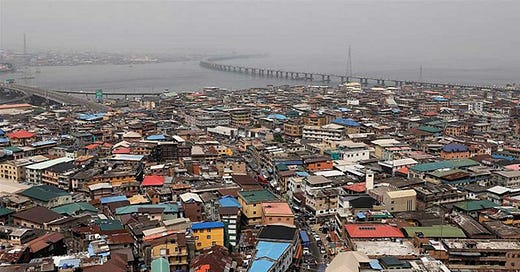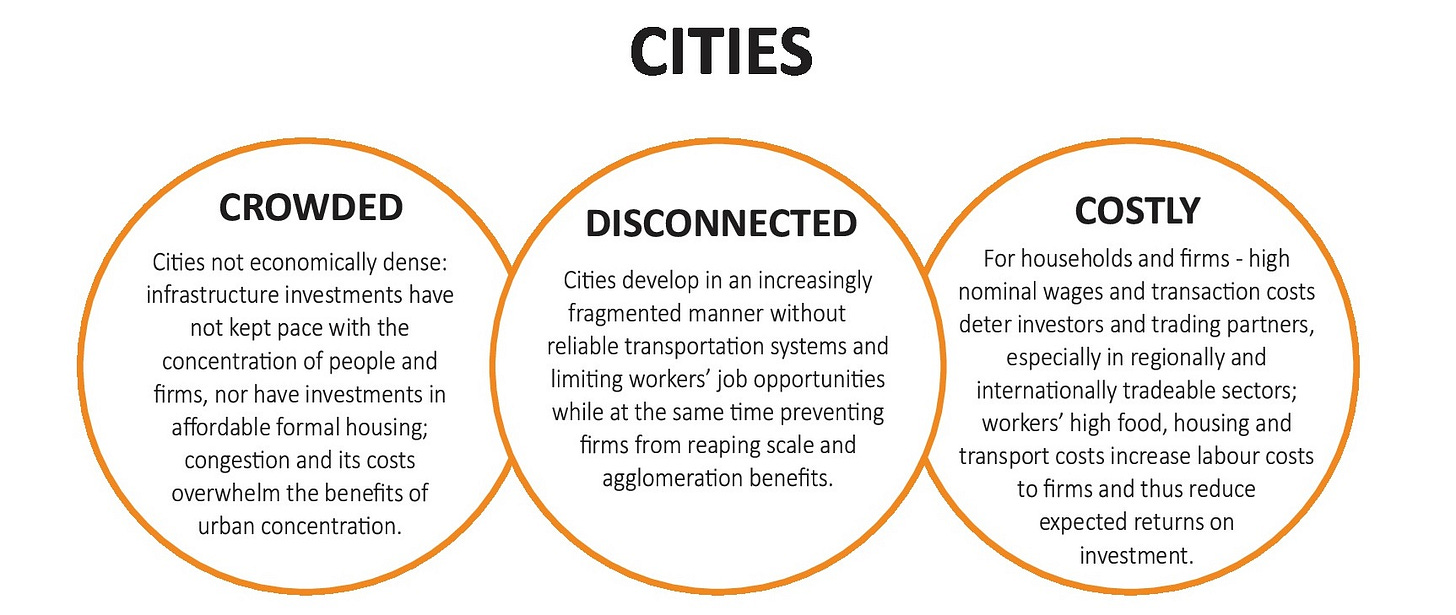Introduction
Urban planning is strategic to national, regional and local development. It is noteworthy that urban planning process outcomes have an impact on different segments of national, regional and local development trajectories from economic, health, governance, security, food production and cultural development among others. The city component of the settlement hierarchy represents one of the platforms urban planning ideas, activities and outcomes are accessed. It is estimated that cities contribute more than 80% of the global gross domestic product (GDP), African cities provide the base for productive economic sectors and UN-Habitat’s World Cities Report 2022 asserted that “…in Africa, one can earn as much as 23 per cent more in cities than in rural areas…”, the city becomes a melting pot.
Figure 1: Sporadic Waterfront Development, Lagos Metropolis, Nigeria
Source: Adapted from Guardian Newspaper, Nigeria
African cities are central to the continent's drive towards enduring development. UN-Habitat’s World Cities Report 2022 posited that among other places African cities will “…experience the biggest increase in the city population share in the future”, this increases the potential of African cities and also create challenges such as population congestion; disconnection dues to fragmented development limiting spatial connectivity and high cost of living and transaction impacting urban livability (See Figure 1 & 2). African cities, therefore, require a strategic and purpose-driven development planning process and framework that is tailor-to-fit to prevailing local social, cultural, economic and governance realities.
Figure 2: African Cities Challenges
Source: Lall, Henderson & Venables, 2017
Globally, development planning initiatives incorporate different agenda, models and mindsets, this is based on the fact that development initiatives anywhere are fashioned to consider global good practices and best practices, thus succinct to postulate that no development initiatives exist in a vacuum. The question would then be, to what degree should external or internal forces and ideas drive a city's development agenda, particularly in African cities? This is where the issue of city development planning dilemma arises.
African and Nigeria Urban Development Planning Dilemma
African countries were colonies of some advanced countries and have often taken cues from these countries in different areas, including urban development planning and management. Nigeria has taken most of her urban development planning ideas, models, curriculum and practice framework from Great Britain, the country’s former colonial master. Noteworthy that taking a cue from a working system is not an entirely bad idea, however, this often results in suppression of local ideas, models and prevailing local peculiarities. Furthermore, African and Nigeria’s urban development planning professionals tend towards often engage in the wholesome adoption of global planning ideas to local situations, hence an African planning dilemma. This constitutes a dilemma in the sense that these adoptions of Western utopian planning ideas and practices often contradict the prevailing realities of African settlement dynamics.
In her inaugural lecture, Taibat Lawanson, a professor of Urban Management and Governance noted the conflicts in African cities between urban managers' utopian ideas and the city's inhabitants’ living realities. She observed that city managers' ideas often derived from the Western world and global agenda varied from the lived experiences of African urban settlement dwellers. This situation often hinders the achievement of most development initiatives (development plans and projects), in that most development initiatives' goals at the onset contradict the living realities of the targeted stakeholders, hence, as often noted in local parlance, the development initiatives become “dead on arrival”. The wholesome adoption of global development trends without adequate consideration of local realities makes the development initiative’s outcome unsuitable to city dwellers. It has resulted in city dwellers' unregulated, sporadic and often time detrimental development practices in African and Nigerian cities notably Lagos, Abuja and Port-Harcourt metropolis among others, Lawanson referred to this as “alternative urbanism”.
Beyond the highlights of the African development planning contradictions, the next strategic steps are to highlight what urban development managers and urban development policymakers should do to address this dilemma. This is a question of how can this dilemma be resolved.
Development Planning Dilemma: What to Do
Taking a cue from Professor Taibat Lawanson's inaugural lecture recommendations, African urban planners and development policymakers need to re-examine African cities' development visioning process, together with the re-consideration of adopted models, planning practices and planning education modules, it is thus incumbent to weave local realities into African cities development trajectories to enhance city development planning agenda. To actualise local realities considerations, the African cities development process should be inclusive considering different strata of the city both formal and informal sectors.
Furthermore, in planning for African and Nigerian cities to reflect local realities without totally jettisoning global good practices and best practices the adoption of conceptual ideals of “Cities for People”, “Just City” and “Right to the City”, are imperative. The city dwellers and their prevailing realities are to be made central to every development initiative, different social strata both formal and informal sectors inclusion in the city developmental trajectory should be a top priority. It is important to note that Western world-focused urban planning models are strategic to generating insights for African and Nigerian city development programmes however, the utopian dimension of these models and dimensions that conflicts with African and Nigerian city's prevailing cultural, social and economic realities and diversities needs to be discarded. Conclusively, African and Nigerian cities planning frameworks should be made to be indigenous, this help ensure cities that are truly African and sustainable as noted by Professor Lawanson in her inaugural lecture.
NOTE
1. Lall, S. V., J. V. Henderson and A. J. Venables (2017) Africa’s Cities: Opening Doors to the World, World Bank, Washington, DC.
2. United Nations Human Settlements Programme (UN-Habitat) World Cities Report 2022: Envisaging the Future of Cities.
3. Professor Taibat Lawanson Inaugural Lecture 2023, “Alternative Urbanisms: Beyond Utopian Visions of the ‘Emerging’ African City”. University of Lagos, Lagos, Nigeria.





